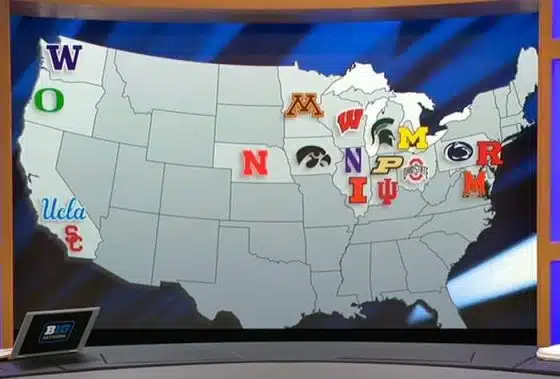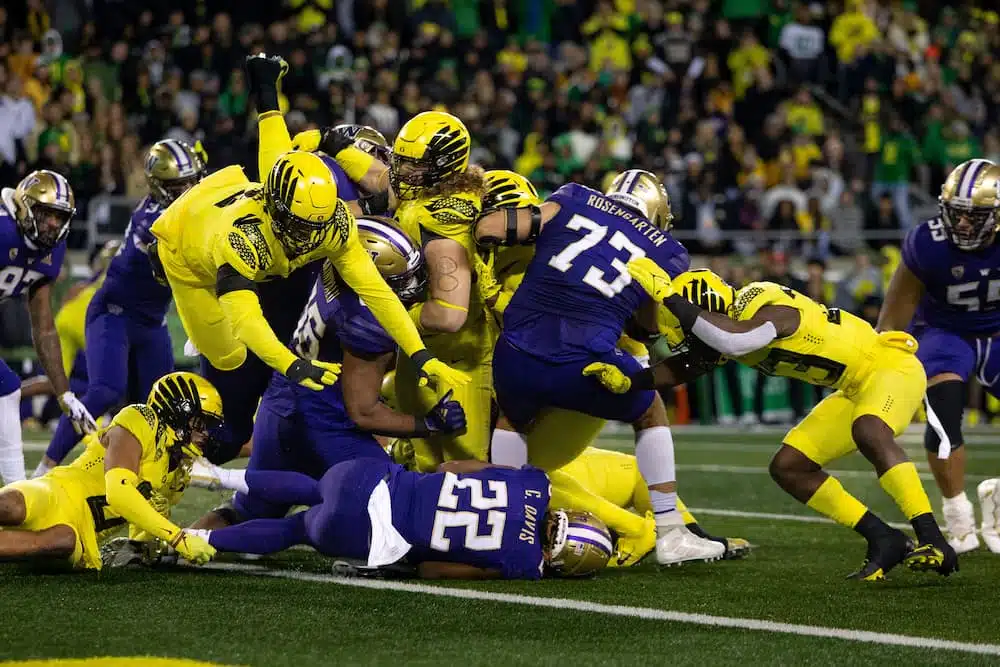The Big Ten Conference’s footprint continues to expand West. A year after adding PAC-12 members UCLA and USC to its portfolio of programs, the Big Ten has once again raided the PAC-12, this time bringing the University of Oregon and the University of Washington into the fold. Oregon, UCLA, USC, and Washington will officially join the Big Ten on August 2, 2024, the league confirmed.
We are excited to welcome the University of Oregon, and the University of Washington to the Big Ten Conference. We look forward to building long-lasting relationships with the universities, administrators and staff, student-athletes, coaches and fans. Both institutions feature a combination of academic and athletic excellence that will prove a great fit for our future.”
- Official Statement from Big Ten Conference Commissioner Tony Petitti
The Ducks’ and Huskies’ move to the Big Ten comes on the heels of reports that the University of Arizona, Arizona State University, and the University of Utah were bolting the PAC-12 for the Big 12. The latter three schools confirmed their decision and were accepted to the Big 12 on Friday evening. In the course of 24-hours, the PAC-12 has been decimated and now has only four member schools, the University of Stanford, the University of California-Berkeley, Oregon State University, and Washington State University, for the 2024 sports calendar year.

The Big Ten –traditionally a Midwest oriented conference– now boasts member schools from New Jersey to California. Additionally, the Big Ten’s footprint now includes the nine of the nations’ top 25 television markets including eight of the top 15 markets. The conference is entering the first year of a seven-year, $7.7 billion TV media rights deal with Fox, CBS, and NBC. Conference member institutions receiving full distribution will receive upwards of $60 million annually from the media rights agreement.
It was the TV money, and the uncertainty surrounding the PAC-12’s media rights deal, that brought the California contingent and eventually the Pacific-Northwest contingent to the Big Ten.
As part of their deal to join the conference, UCLA and USC will receive a full share of the media rights money immediately upon joining the Big Ten in 2024. Oregon and Washington will have to follow the path of previous Big Ten additions, the University of Nebraska (2011), the University of Maryland (2014), and Rutgers University (2014), all of whom received a lower share that increased over time.
A Timeline of Big Ten Expansion
- 1896: Illinois, Michigan, Wisconsin, Minnesota, Purdue, Univ. of Chicago, and Northwestern form the “Western Conference”
- 1899: Iowa and Indiana join, the conference is referred to as the “Big Nine”
- 1907: Michigan is voted out of the conference
- 1912: Ohio State joins the conference
- 1916: Michigan rejoins, the conference is first referred to as the “Big Ten”
- 1946: Univ. of Chicago de-emphasizes varsity athletics and leaves the conference; the conference is once again referred to as the “Big Nine”
- 1949: Michigan State joins, the conference is once again referred to as the “Big Ten”
- 1993: Penn State begins conference play after being invited to join in 1990
- 2011: Nebraska joins the conference
- 2014: Maryland and Rutgers join the conference
- 2022: UCLA and USC announce they will join the conference effective in 2024
- 2023: Oregon and Washington announce they will join the conference effective in 2024
The addition of Oregon and Washington, charter members of the then-Pacific Coast Conference in 1915, will bring the Big Ten to 18-teams for the 2024 athletic calendar year. There’s a belief that the Big Ten will likely expand to 20-teams with surviving PAC-12 members Stanford and Cal mentioned as potential fits for academic reasons. Other schools mentioned as potential Big Ten targets include the ACC’s University of North Carolina and the University of Virginia. Adding schools from the ACC could prove difficult for the Big Ten because ACC programs are locked into a “Grant of Rights” agreement that states the conference will own the broadcast rights to all its member schools until 2036.
So, for now, the Big Ten will likely sit and wait for the next shoe to drop in the crazy world of college football realignment.








